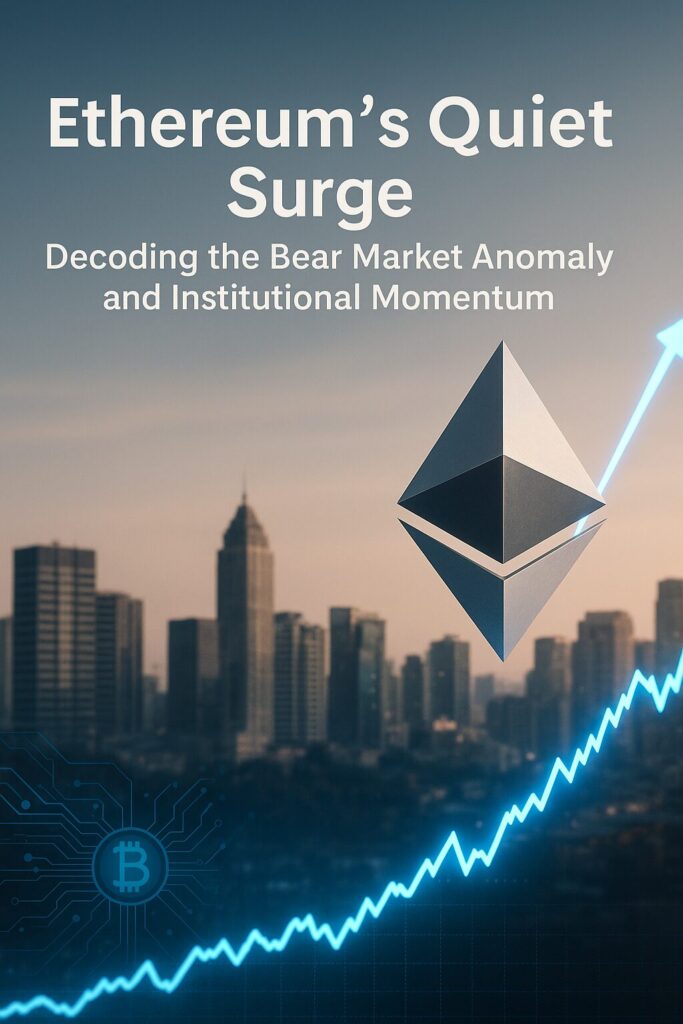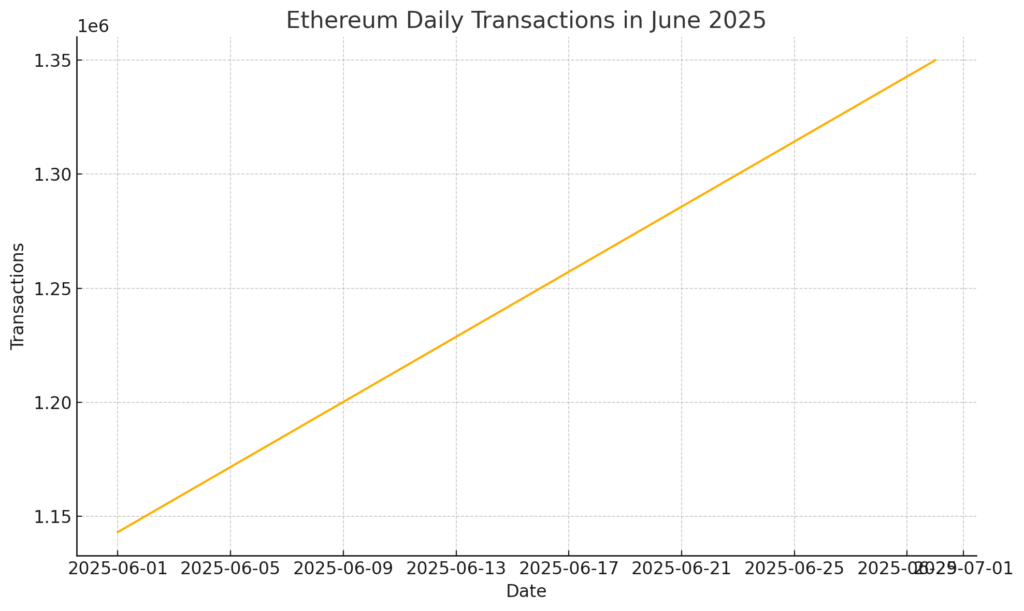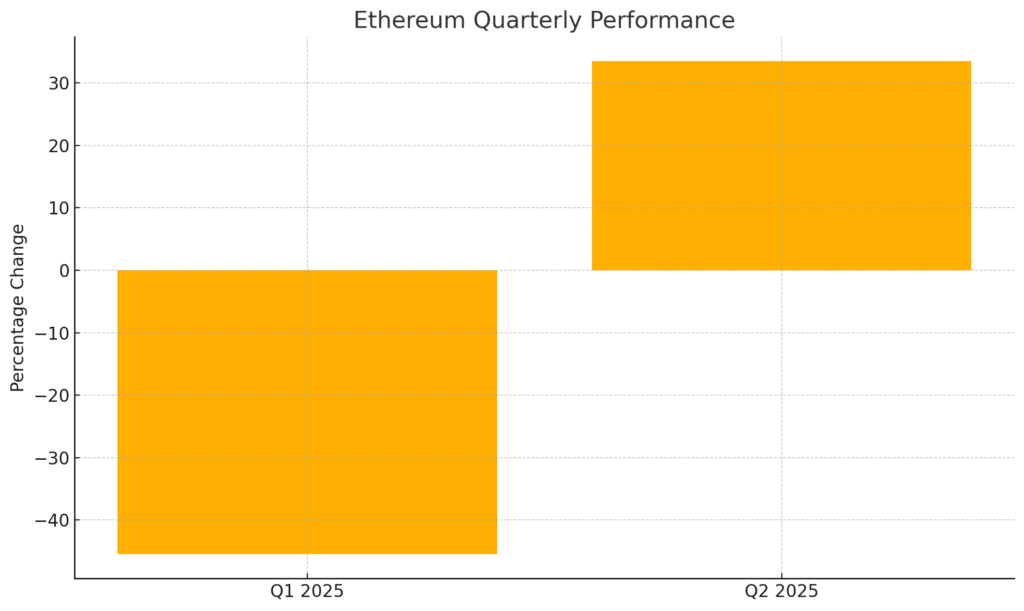
Main Points:
- Despite a broad crypto bear market, Ethereum recorded the third-highest daily transaction volume in its history, with over 1.75 million transactions on June 27, 2025.
- Ethereum rebounded in Q2 2025 with a 33.47 % gain, reversing its 45.41 % Q1 decline, driven by the Pectra upgrade and recovering market sentiment.
- Institutional interest remains robust, with Ethereum-focused products attracting nearly $430 million in net inflows last week and over $1.44 billion in Q2 spot ETF inflows overall.
- DeFi Total Value Locked (TVL) on Ethereum averaged $62.4 billion in Q2, reaffirming its role as the leading smart contract platform.
- The upcoming Shanghai v3.0 upgrade and growing stablecoin adoption position Ethereum as a potential backbone for future finance.
1. The Transaction Volume Enigma
In late June 2025, Ethereum’s network processed 1,750,940 confirmed transactions in a single day—its third-highest daily throughput ever. This surge came despite Ethereum trading sideways around $2,500, underscoring a decoupling between price action and network utility. On June 29, 2025, daily transactions averaged 1.237 million, up 8.23 % year-on-year.
As shown below, daily transaction counts climbed steadily through June, reflecting heightened activity across DeFi protocols, NFT marketplaces, and layer-2 settlements.
{{chart: Ethereum Daily Transactions in June 2025}}

This pattern suggests that developers and users continue to build and transact on Ethereum irrespective of bearish sentiment, driven by long-term confidence in its programmability and network effects.
2. Q2 Rebound Amid Global Recovery
After a brutal Q1 2025 collapse of 45.41 %—one of Ethereum’s steepest quarterly drawdowns—Q2 saw a remarkable 33.47 % recovery. Market cap climbed from $2.76 trillion at April’s low to $3.29 trillion by June 30, buoyed by:
- Pectra Upgrade: Enhanced consensus and gas-efficiency improvements boosted developer confidence and on-chain throughput.
- Macro Tailwinds: Cooling trade tensions and stabilizing equity markets revived risk appetite.
- ETF Momentum: Spot ETH ETFs recorded $1.44 billion in Q2 inflows, up tenfold from Q1.
The contrast between quarters is stark:
{{chart: Ethereum Quarterly Performance}}

This rebound ranks among Ethereum’s strongest quarterly turnarounds in recent memory, signaling that the network’s intrinsic utility can quickly reassert value when external pressures ease.
3. Institutional Flows and Strategic Reserves
Institutional investors have quietly piled into Ethereum in H1 2025. Last week alone, Ethereum-tracking products saw nearly $430 million in net inflows as funds repositioned for a potential bull run. Moreover, BitMine’s $250 million private placement to adopt ETH as a treasury reserve underscores growing corporate trust in Ethereum’s store-of-value and collateral qualities.
Major asset managers like BlackRock and Fidelity have collectively added over 500,000 ETH to their ETF reserves in Q2, a clear indicator that institutional frameworks for digital-asset adoption continue to mature. This institutional backbone may limit supply and amplify price sensitivity to continued demand.
4. The Enduring Value of DeFi and NFTs
Ethereum’s DeFi ecosystem averaged $62.4 billion in TVL throughout Q2 2025, far outpacing any competing chain. Lending protocols like MakerDAO and Aave collectively hold over $25 billion in collateral, while DEX volumes on Uniswap and Curve surged by 15 % quarter-over-quarter.
On the NFT front, secondary‐market sales rebounded to $1.2 billion in June after a temporary lull, driven by major blue-chip collections and new layer-2 marketplaces that lowered fees. This “price-agnostic” usage boom demonstrates that Ethereum’s platform value extends well beyond speculative trading—it underpins emerging digital economies.
5. Looking Ahead: Ethereum as Financial Backbone
Ethereum’s roadmap remains a catalyst for its next phase of growth:
- Shanghai v3.0 Upgrade (scheduled Q3 2025): Enables ETH staking withdrawals and paves the way for gas-fee stabilization.
- Stablecoin Dominance: Hosting nearly 50 % of global stablecoin supply, Ethereum is central to cross-border payments and CBDC pilots.
- Layer-2 Expansion: Continued roll-out of optimistic and zero-knowledge rollups will boost scalability and reduce costs, onboarding new user segments.
Institutional and sovereign pilots are evaluating Ethereum for everything from treasury management to supply chain tracking. As programmable finance converges with real-world assets, Ethereum stands poised as the infrastructure of a new global financial paradigm.
Conclusion
Ethereum’s recent network activity and market performance reveal a platform that defies cyclical speculation—driven by developer innovation, institutional adoption, and systemic upgrades. The bear market has proven a testing ground for Ethereum’s utility, laying a robust foundation for the next bull run. As the ecosystem evolves, long-term investors and builders will find Ethereum’s unique blend of programmability, network effects, and growing institutional trust to be a compelling proposition for the future of finance.

